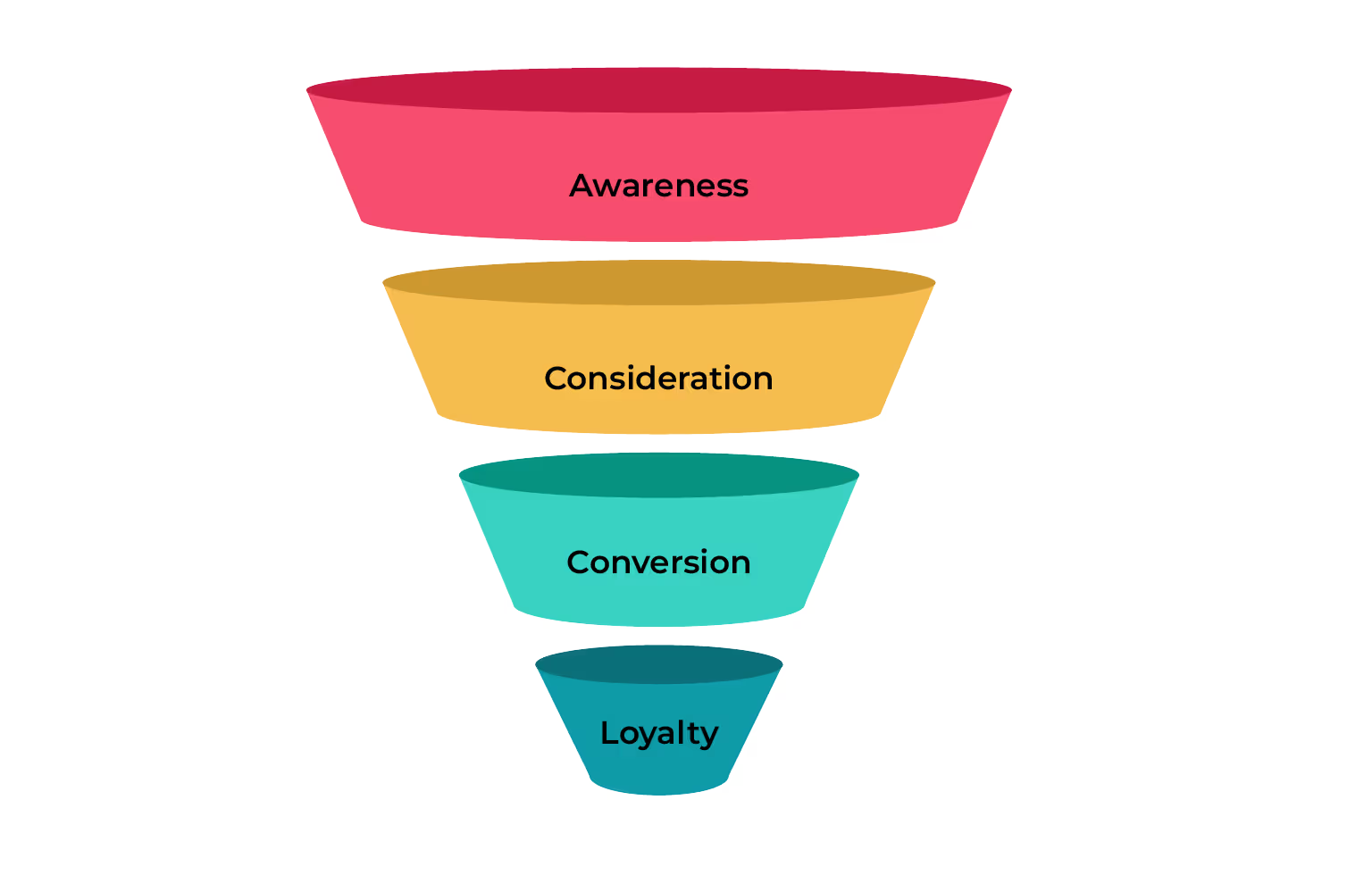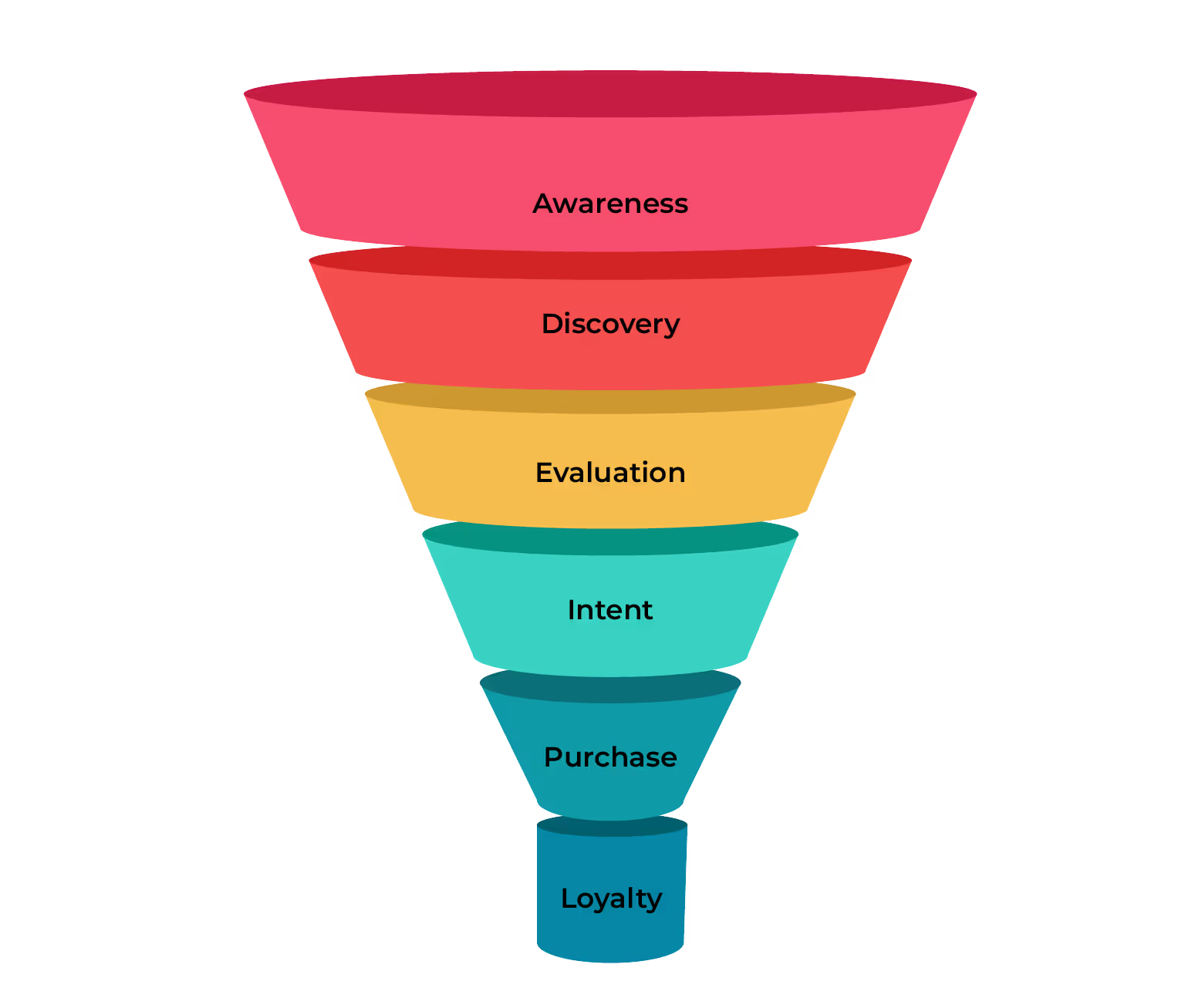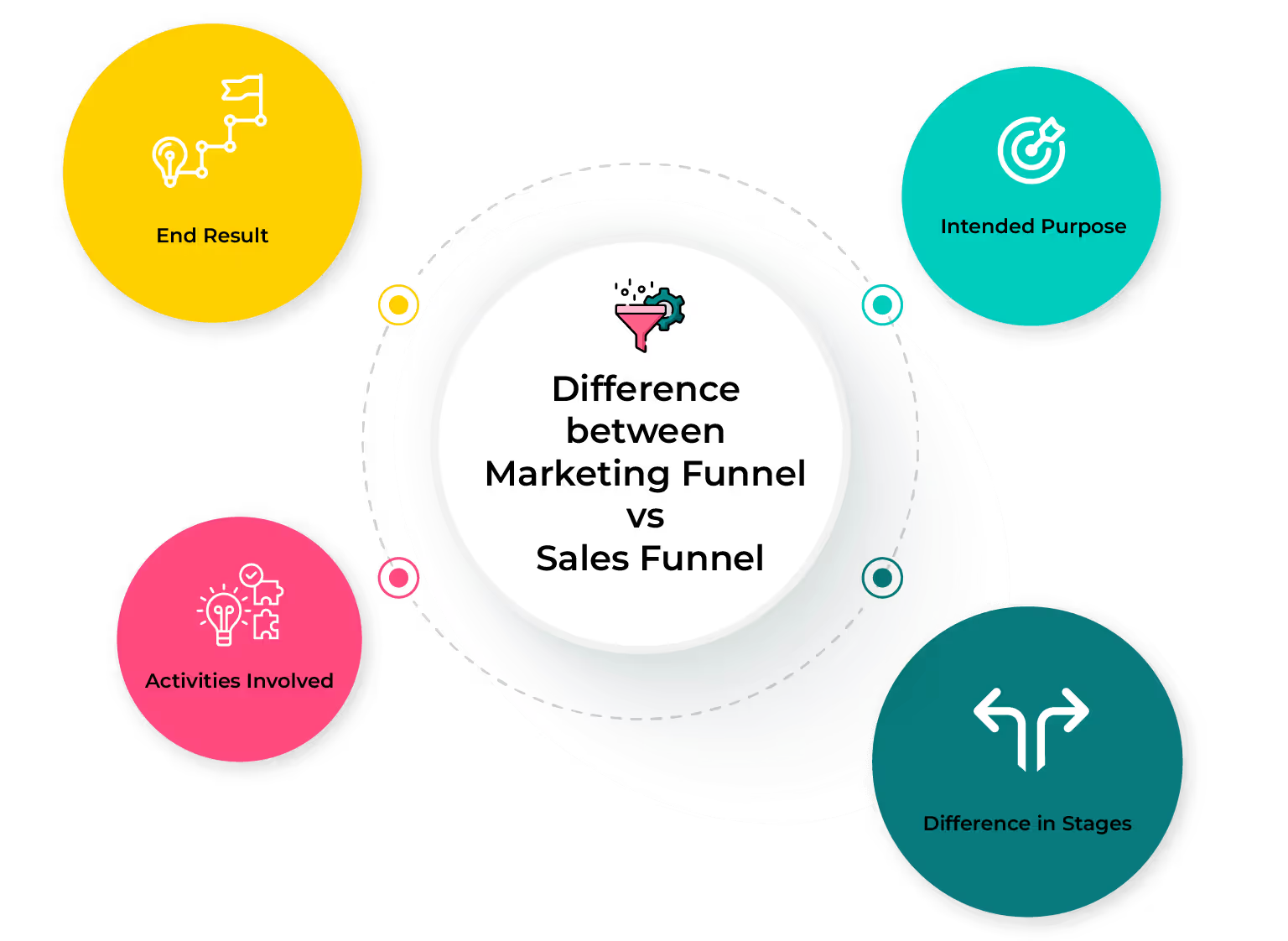
Blog
Sales Funnel vs Marketing Funnel: What’s the Difference
November 10, 2023


Key Insights
Having a systematic approach to business helps get a clarity and visibility of your operations.
Surely there are many tools that help organizations bring in that order and provide their team with a roadmap.
CRMs, sales funnels and pipelines, marketing funnels, performance management tools, are some of the few tools in the long list that helps ease the everyday operations and streamline the process.
In this article, we will take up two relevant tools - sales funnels and marketing funnels. We define marketing funnel vs sales funnel, differentiate marketing funnel vs sales funnel, and explore the key benefits of incorporating these tools in your operations.
Additionally, we'll clarify the distinction between sales funnel and sales pipeline to help you maximize your sales strategies.
Scroll down for more.
What is a marketing funnel?
A marketing funnel is a visual representation of the various stages of marketing activities from bringing in brand awareness among customers, driving them to consider the product, deciding to buy the product to eventually turning them into loyal customers.
The four common stages of a marketing funnel include awareness, consideration, conversion, and loyalty. The marketing funnel is represented as an inverted funnel that narrows down as the prospect moves from awareness to making a purchase.
Different stages of the marketing funnel

- Awareness
The awareness stage is the top of the marketing funnel where potential customers become aware of a brand, product, or service.
- Consideration
In the consideration stage, potential customers are actively exploring, evaluating their options, and seeking more information to finally consider the product or service for a purchase.
- Conversion
In the conversion stage, the potential customer decides to become an actual customer and subscribes to the use of the product or service.
- Loyalty
The loyalty stage includes the post-purchase activities that ensure the satisfaction of customers to repeat purchases, engage with the brand, and become loyal advocates who recommend it to others.
For example: When a new product is launched, companies first try to spread the word so that people become aware of it. Then they sent out blogs, videos, advertisements, etc. to educate people to know more about their product.
In the third stage, they provide discounts and offers that persuade the prospect to buy the product. After the conversion, companies provide perks and rewards for existing customers to ensure their satisfaction and repeated use of the product.
Marketing funnel helps keep track of the customer journey as each stage requires tailored strategies and content to address the specific needs and behaviors of the audience. It helps optimize and improve the efficiency of marketing efforts leading to successful customer acquisition and retention.
What is a sales funnel?
A sales funnel is a visual representation of the different stages of the customer journey initiated by the sales activities. It traces the prospect's decisions from the initial contact with the sales reps to finally becoming a loyal customer.
The sales funnel is also represented inverted and the customer travels through six stages to finally become the ideal customer. These stages include awareness, discovery, evaluation, intent, purchase, and loyalty.

- Awareness
Awareness is the initial stage where potential customers become aware of a product or service and get introduced to the brand.
- Discovery
In the discovery stage, potential customers actively seek more information about the product or service and start to explore and discover what's available in the market.
- Evaluation
In the evaluation stage, potential customers consider the product in more detail by weighing the pros and cons, comparing it with alternatives, and assessing how well it meets their specific needs.
- Intent
When the potential customer reaches the intent stage they have done their research and are ready to move forward with a clear intention to make a purchase.
- Purchase
Purchase is the stage where the customer completes the purchase and becomes a paying customer.
- Loyalty
The loyalty stage focuses on retaining customers, ensuring their satisfaction, repeating purchases, and recommending the product or service to others.

For example: A brand launches a new product and runs advertisements on platforms where their ideal customers are present the most. These ads help customers be aware of the new launch. Intended customers might search more to discover the new features included.
When they become interested in it they evaluate other similar products to understand its worth. Soon they will show the intent and finally purchase it. Regular updations, proper services, and other customer-centered approaches help turn them into loyal customers.
To ensure quick decision-making and a faster customer journey through the sales funnel, companies must ensure they apply the right strategies and tactics to persuade them to make the purchase and build long-lasting relationships.
What is the difference between Marketing Funnel vs Sales Funnel
To differentiate marketing funnel vs sales funnel is difficult. One reason is that they both involve similar strategies and tactics to generate leads and convert prospects to potential customers. Effective sales funnel management is crucial for optimizing the conversion process and driving sales success.
It can be said that the customer journey through the sales funnel is a part of the earlier stages covered by the marketing funnel. Within this context, Salesforce Opportunity Stages play a vital role in tracking and managing prospects as they progress through these interconnected stages, ensuring a streamlined and organized sales process.

- Intended Purpose
Marketing funnel is more focused on bringing brand awareness and persuading people to consider the product. While the sales funnel takes charge after the lead is generated to drive them to becoming paying customers. Hence marketing funnel’s intended purpose is to generate awareness and sales funnel to generate revenue.
- Difference in Stages
The different stages of the marketing funnel focus on creating and maintaining the brand identity and building long-lasting relationships with customers. While the sales funnel is product-oriented, as they become aware of the product, evaluate it alongside others, and then choose to become trusted customers. Within the lead funnel stages, prospects are carefully nurtured, guiding them from initial interest to becoming qualified leads ready for the sales process.
- Activities Involved
The marketing and sales activities are different but interconnected to generate leads and close deals. Marketing funnel focuses on sharing blogs, creating advertisements in social media and organizing webinars to bring awareness. While sales funnel create connections through LinkedIn networks, email campaigns, sales calls etc.
- End Result
The initial stages of both the marketing and sales funnel are similar as both try to bring awareness to their prospects and persuade them to consider the product. While the end results of both are different. Marketing funnel ensures larger brand awareness and customer base. While the sales funnel ensures a higher number of sales closed and revenue generated.
Though they serve different purposes and represent distinct stages in the overall customer journey, the marketing funnel and the sales funnel are closely related and often work hand in hand. It is this combined marketing and sales efforts that ensures acquiring and retaining customers throughout the entire process.
Integrating Marketing and Sales Funnels for Better Results:
While marketing and sales funnels serve distinct purposes, their integration is crucial for maximizing conversion rates and driving revenue. Here's how to effectively integrate these funnels:
- Align marketing and sales teams for seamless collaboration: Foster open communication and collaboration between marketing and sales teams.
This involves establishing regular meetings, shared goals, and a clear understanding of each team's roles and responsibilities.
When these two teams work together, it creates a much smoother experience for the customer.
- Share data between teams to improve lead quality: Implement systems that allow for seamless data sharing between marketing and sales.
Marketing can provide insights into lead behavior and engagement, while sales can provide feedback on lead quality and conversion rates.
This shared data helps refine lead qualification criteria and improve the efficiency of the sales process.
- Create a unified customer journey from awareness to loyalty: Design a customer journey that seamlessly transitions leads from the marketing funnel to the sales funnel.
This involves creating consistent messaging, branding, and customer experience across all touchpoints.
By creating this unified journey, you increase the likelihood of customer loyalty.
Key benefits of having a structured funnel
Even with their varied purpose, incorporating marketing and sales funnel in business operations offers several key benefits:
- A funnel provides a clear visualization of the customer journey which helps strategize timely plans that ensure faster conversion rate and higher closing of deals.
- The visibility in customer journey helps categorize and prioritize the leads, focus the attention and allocate resources to optimize the marketing and sales initiatives.
- A systematic approach to sales and marketing efforts helps enhance the conversion rate and thereby increase the revenue generated, supported by valuable insights from a robust sales pipeline calculator.
- Incorporating tools like marketing and sales funnel provide valuable data and insights that helps companies make informed decisions thereby ensuring the effectiveness of their strategies.
- Monitoring customer journey through funnel helps sales and marketing to personalize their content to the needs, requirements and interest of the prospective customer. These minute details help increase the overall customer experience.
- Sales and marketing funnel are perfect tools to measure the effectiveness of the sales and marketing strategies as well as sales and marketer performance.
Incorporating a marketing and sales funnel in business operations offers a roadmap for customer acquisition and helps businesses to enhance their overall efficiency and effectiveness in converting potential leads into trusted customers.
Summing up
Incorporating tools and techniques are the best way to build a structure and system for your business operations. Utilizing incentive compensation management software not just creates a framework on how to go about the task but is also backed by data, making it effective in ensuring that your incentive programs are accurately designed, administered, and optimized for maximum impact on performance and motivation.
With digital transformation sweeping the business operation realm, incorporating tools that can run in cruise mode is a necessity.
Especially in sales and marketing where a huge budget is allocated for its smooth functioning and to reap positive outcomes, it is important that the operations are backed by latest technological aids.
Kennect offers incentive compensation and sales performance management tools to create transparency and achieve operational efficiency. For more information, Book A Demo Now!
ReKennect : Stay ahead of the curve!
Subscribe to our bi-weekly newsletter packed with latest trends and insights on incentives.
Thank you! Your submission has been received!
Oops! Something went wrong while submitting the form.
Your data is in safe hands. Check out our Privacy policy for more info















